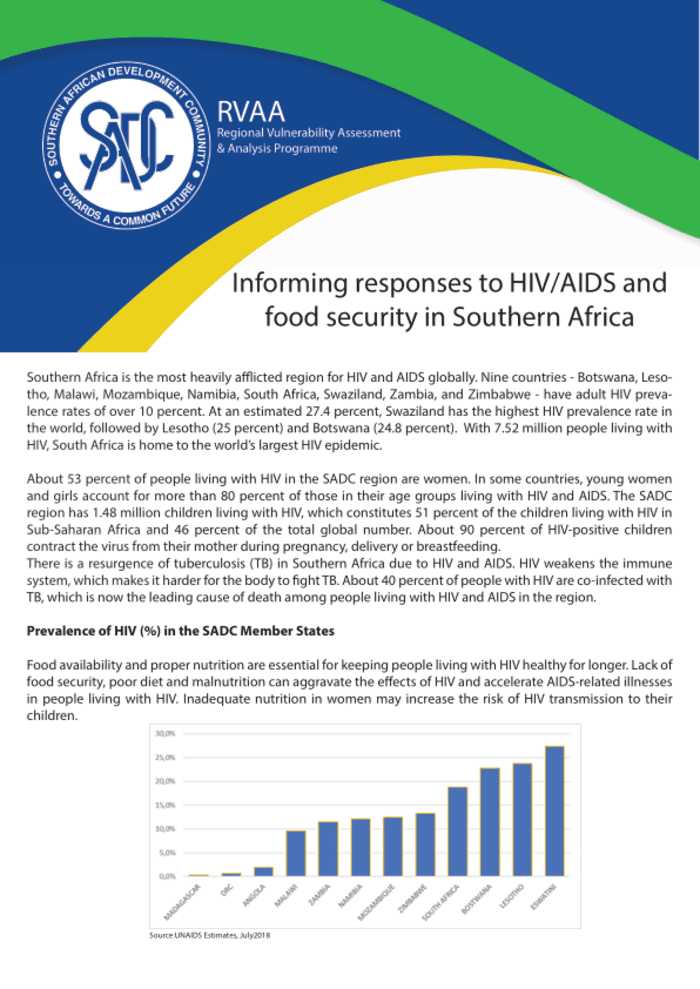Attachments
Southern Africa is the most heavily afflicted region for HIV and AIDS globally. Nine countries – Botswana, Lesotho, Malawi, Mozambique, Namibia, South Africa, Swaziland, Zambia, and Zimbabwe – have adult HIV prevalence rates of over 10 percent. At an estimated 27.4 percent, Swaziland has the highest HIV prevalence rate in the world, followed by Lesotho (25 percent) and Botswana (24.8 percent). With 7.52 million people living with HIV, South Africa is home to the world’s largest HIV epidemic.
About 53 percent of people living with HIV in the SADC region are women. In some countries, young women and girls account for more than 80 percent of those in their age groups living with HIV and AIDS. The SADC region has 1.48 million children living with HIV, which constitutes 51 percent of the children living with HIV in Sub-Saharan Africa and 46 percent of the total global number. About 90 percent of HIV-positive children contract the virus from their mother during pregnancy, delivery or breastfeeding. There is a resurgence of tuberculosis (TB) in Southern Africa due to HIV and AIDS. HIV weakens the immune system, which makes it harder for the body to fight TB. About 40 percent of people with HIV are co-infected with TB, which is now the leading cause of death among people living with HIV and AIDS in the region.
Prevalence of HIV (%) in the SADC Member States
Food availability and proper nutrition are essential for keeping people living with HIV healthy for longer. Lack of food security, poor diet and malnutrition can aggravate the effects of HIV and accelerate AIDS-related illnesses in people living with HIV. Inadequate nutrition in women may increase the risk of HIV transmission to their children.
The HIV pandemic mostly affects sexually active adults in the 20- to 39-year age group, who are the primary household providers. As more adults are affected by HIV, food production may drop due to a decrease in labor force and productivity. Ultimately a decline in national food supplies may contribute to a rise in food prices.
In line with the SADC HIV and AIDS Strategic Framework, Member States are implementing interventions including condom use promotion and distribution; behaviour change communication; HIV testing and counselling; safe medical circumcision; mainstreaming HIV and AIDS across all sectors; prevention of mother to child transmission (PMTCT); and treatment and home-based care. Notwithstanding the interventions mentioned above, the HIV and AIDS burden remains heavy, necessitating scaling up investments, interventions, and awareness in the SADC region.
Global, Regional and National commitments on HIV reduction
• Article 9 of the SADC Health Protocol addresses communicable disease control and Articles 10 through 12 look specifically at HIV and AIDS, malaria and TB.
• The “Declaration on HIV and AIDS “recognizes commitments made thus far, acknowledges that the HIV/AIDS pandemic can be curbed, that collaboration on various socio-economic improvements can combat poverty, and that upholding human rights combats stigma.
• Articles 26 and 27 of the SADC Protocol on Gender and Development mandate Member States to address gender-specific health care needs related to HIV and AIDS.
• The SADC HIV and AIDS Strategic Framework aims at intensifying measures and actions to address the impact of the HIV and AIDS pandemic in a comprehensive and complementary way.
The role of the Regional Vulnerability Assessment and Analysis (RVAA) Programme The RVAA Programme coordinates and supports SADC Members States through National Vulnerability Assessment Committees (NVACs) to undertake annual vulnerability assessments and analysis. Such analysis is a critical input to both emergency response and development programming, and used by both governments and partners.
To provide more comprehensive assessment and analysis of the causes of chronic vulnerability in the region to inform longer-term programming, the RVAA Programme has integrated HIV into vulnerability assessments and analysis.
The Programme raises awareness among policymakers, development partners and the public on the need to integrate HIV and AIDS considerations and objectives in food security policies and programmes. In 2013 a Technical Working Group (TWG) was formed to provide guidance on the integration of HIV and AIDS into the vulnerability assessments and analysis. TWG also works to strengthen the capacity of NVACs in integrating HIV and AIDS into vulnerability assessments and analysis.
The TWG group spearheaded the development of SADC Guidance on Integration of Nutrition, HIV, and Gender in Vulnerability Assessments and Analysis for NVACs in 2015. The document provides reviews of approaches, methodologies, and tools for integrating nutrition into the vulnerability assessments and analysis, adaptable to specific country contexts.
The minimum set of indicators for which NVACs have committed to collect information includes HIV-related chronic illnesses, orphans, child-headed households and the effective dependency ratio.
Source link : https://reliefweb.int/report/eswatini/informing-responses-hivaids-and-food-security-southern-africa
Author :
Publish date : 2019-01-24 03:00:00
Copyright for syndicated content belongs to the linked Source.
